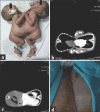Conjoined Thoracopagus Twins - Our Experience of Successful Separation
- PMID: 34728927
- PMCID: PMC8515522
- DOI: 10.4103/jiaps.JIAPS_175_20
Conjoined Thoracopagus Twins - Our Experience of Successful Separation
Abstract
Conjoined twin is an extremely rare condition and needs a thorough knowledge of anatomy and a multidisciplinary approach is essential to successfully separate, the twins. Thoracopagus are the twins attached by chest and umbilicus and are the commonest among all the varieties but carries a poor survival rate. We describe our approach and experience of management of thoracopagus twins who were separated at eighty-three day of life and are alive and well after 4 years of follow up. The most important decisive parameter for successful separation is the extent of sharing of organs between twins but the role of a motivated multidisciplinary team is also indispensable.
Keywords: Conjoined twins; the survival of thoracopagus twins; thoraco-omphalopagus twins; thoracopagus twins.
Copyright: © 2021 Journal of Indian Association of Pediatric Surgeons.
Conflict of interest statement
There are no conflicts of interest.
Figures



References
-
- Spitz L, Kiely EM. Experience in the management of conjoined twins. Br J Surg. 2002;89:1188–92. - PubMed
-
- Rode H, Fieggen AG, Brown RA, Cywes S, Davies MR, Hewitson JP, et al. Four decades of conjoined twins at Red Cross Children's Hospital--lessons learned. S Afr Med J. 2006;96:931–40. - PubMed
-
- Spencer R. Theoretical and analytical embryology of conjoined twins: Part 1: Embryogenesis. Clin Anat. 2000;13:36–53. - PubMed
Publication types
LinkOut - more resources
Full Text Sources
